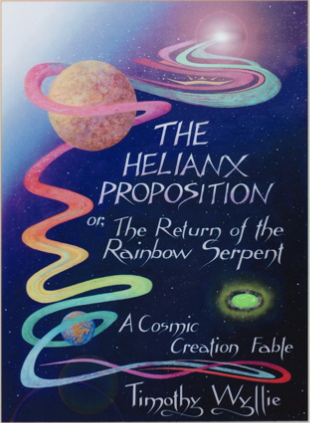Difference between revisions of "The Helianx Proposition/cover"
| Line 2: | Line 2: | ||
[[Image:Helianxcover1.jpg|right]] | [[Image:Helianxcover1.jpg|right]] | ||
| − | '''The Helianx Proposition''' is a [[cosmic]] fable, a [[creation]] [[myth]] that floated down | + | '''The Helianx Proposition''' is a [[cosmic]] fable, a [[creation]] [[myth]] that floated down one late night in 1979 in an unbroken six-hour stretch of writing after contemplating the deeper symbolic meaning of the traditional [[Christian]] [[Garden of Eden]] scene and wondering, yet again, what on earth the Serpent was doing there. Since the creature's impact on the two [[human|humans]] was apparently so profound, it appeared that perhaps the Serpent, too, had a [[divine]] origin and a valuable function to perform. At that point The Helianx Proposition started writing itself. |
| − | + | The next 20 years were spent illustrating and [[calligraphy|calligraphing]] the story using graphite on parchment as the [[medium]] always intending to do them in [[color]] and that when the time was right, computer technology would allow coloring the black and white images. | |
| − | By 2001, the [[technology]] had arrived in affordable form and | + | By 2001, the [[technology]] had arrived in affordable form and then the black and white pages were digitally photographed and printed on watercolor paper using a high-end ink jet technology called [[Giclee]] printing. After learning [[Adobe Photoshop]] with the idea of using software to color the images. it would become clear that even more time might be required to color the pages digitally than to do it by hand--and not half as much fun. Consequently, the addition of color to the printed image was made by applying dry [[pigments]], rephotographing the image, and then cleaning it up and make any minor adjustments using Adobe Photoshop before printing the page. |
| − | The Helianx Proposition will be available at some point in the future in three forms | + | The Helianx Proposition will be available at some point in the future in three forms, 1) a limited edition of handmade books on [[materials]] designed to last many generations; 2) a boxed set in which interested readers might build themselves by purchasing archival prints page by page; and 3) a traditional coffee table edition which may be picked up by a publisher of such books. |
| − | Because of the fluid and seamless way in which the Helianx Proposition came through originally | + | Because of the fluid and seamless way in which the Helianx Proposition came through originally it is evident, there may be elements of considerable interest to the contemporary [[cosmology|cosmologist]], and which will perhaps add some insight into the odd persistence of the presence of dragons, [[cosmic]] snakes and rainbow serpents in the stories we have told ourselves over the thousands of years of [[human]] [[history]]. |
[[Category: Books]] | [[Category: Books]] | ||
[[Category: Languages and Literature]] | [[Category: Languages and Literature]] | ||
[[Category: Prints]] | [[Category: Prints]] | ||
Revision as of 19:05, 18 February 2008
The Helianx Proposition is a cosmic fable, a creation myth that floated down one late night in 1979 in an unbroken six-hour stretch of writing after contemplating the deeper symbolic meaning of the traditional Christian Garden of Eden scene and wondering, yet again, what on earth the Serpent was doing there. Since the creature's impact on the two humans was apparently so profound, it appeared that perhaps the Serpent, too, had a divine origin and a valuable function to perform. At that point The Helianx Proposition started writing itself.
The next 20 years were spent illustrating and calligraphing the story using graphite on parchment as the medium always intending to do them in color and that when the time was right, computer technology would allow coloring the black and white images.
By 2001, the technology had arrived in affordable form and then the black and white pages were digitally photographed and printed on watercolor paper using a high-end ink jet technology called Giclee printing. After learning Adobe Photoshop with the idea of using software to color the images. it would become clear that even more time might be required to color the pages digitally than to do it by hand--and not half as much fun. Consequently, the addition of color to the printed image was made by applying dry pigments, rephotographing the image, and then cleaning it up and make any minor adjustments using Adobe Photoshop before printing the page.
The Helianx Proposition will be available at some point in the future in three forms, 1) a limited edition of handmade books on materials designed to last many generations; 2) a boxed set in which interested readers might build themselves by purchasing archival prints page by page; and 3) a traditional coffee table edition which may be picked up by a publisher of such books.
Because of the fluid and seamless way in which the Helianx Proposition came through originally it is evident, there may be elements of considerable interest to the contemporary cosmologist, and which will perhaps add some insight into the odd persistence of the presence of dragons, cosmic snakes and rainbow serpents in the stories we have told ourselves over the thousands of years of human history.
